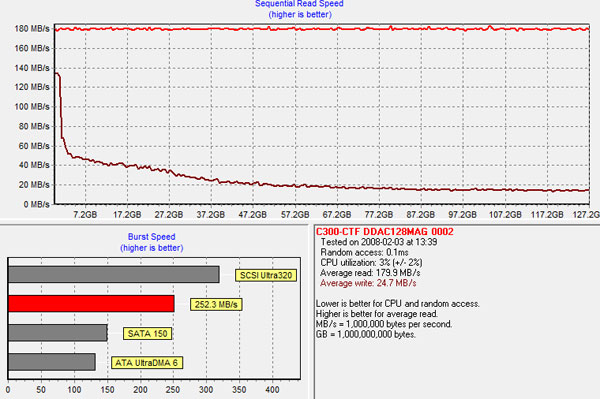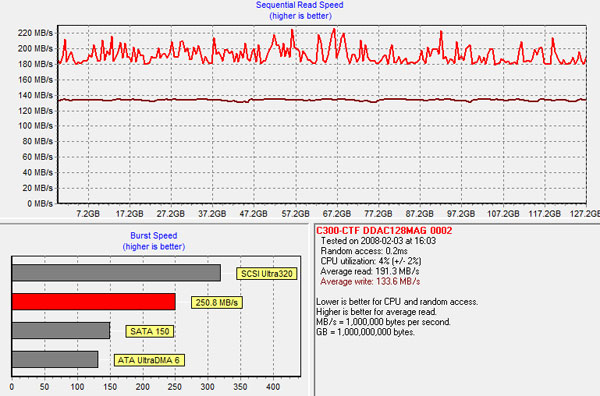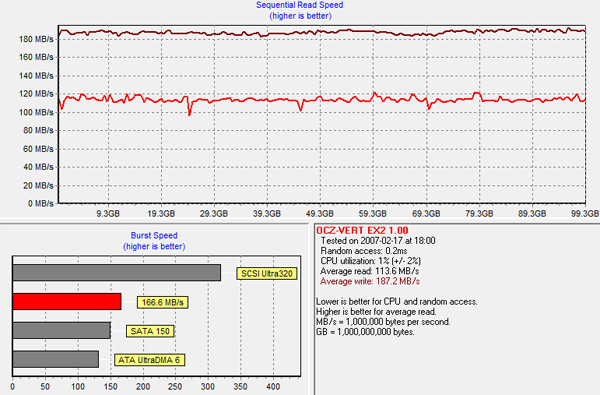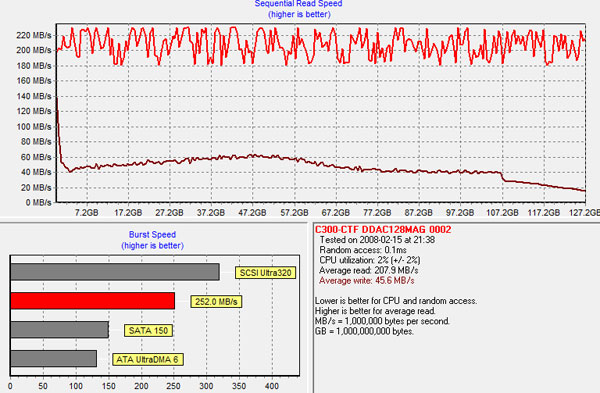The SSD Diaries: Crucial's RealSSD C300
by Anand Lal Shimpi on July 13, 2010 12:39 AM ESTTRIM and Performance over Time
When I first tested the C300 I noted that it fell victim to the same bug that plagued Intel’s X25-M: throw a bunch of random writes at the drive and it’ll get backed into a corner that it’ll never get out of. The scenario that you have to create to force the drive into this condition isn’t realistic at all, however that isn’t to say that over months or years of heavy use that you wouldn’t find yourself in the same situation. Either way, Crucial corrected the problem and spent weeks validating the firmware fix. Crucial did continue to sell drives during this period, which I wasn’t exactly happy about.
Either way the problem is now fixed with the 0002 firmware revision. It’s a destructive firmware update so you’ll lose any and all data on your drive after applying it. I also had a strange issue where the update had to be applied twice on my 256GB drive before it would work properly. Here’s what the C300’s performance looks like after being hammered for 20 minutes with random writes:

Ouch. Writes drop down to a dismal 20MB/s. But now if we TRIM the contents of the drive the performance curve looks like this:

Writes are at about 140MB/s and reads are in the low 200s. Everything is back to normal.
Now note that unlike the SandForce drives, Crucial’s controller/firmware combination will let the drive get into this state. Even if I throw randomly generated data at a SandForce drive the performance remains very high (the drive in the chart below is OCZ's Vertex 2):

Note that the lower line actually represents read performance - write speed is still up above 180MB/s.
The C300’s performance is simply not as resilient as what SandForce has to offer. For the majority of users this isn’t a problem. Typical desktop workloads shouldn’t get the drive into this state. Add in the efficiency of Crucial’s TRIM implementation and you should never see such a drop. However if your workload is atypical or particularly write intensive, the C300 may not be a good fit.
The C300 does perform background garbage collection. I’ve never particularly been a fan of idle GC simply because it fixes a problem after it’s created rather than avoiding the problem altogether. If you don’t have TRIM however (running RAID, Mac OS X, any Windows OS other than 7), idle GC is all you can rely on.
How well does it work? I subjected my 128GB C300 to almost the same torture test I mentioned above. I filled the drive to 80% of its total capacity and then threw random writes all over the drive for 20 minutes straight. Performance was predictably bad:

I left 20% of the drive empty because free space is needed for the idle GC to take effect. Here’s what the drive’s performance looked like after being idle for 3 hours:

Not exactly a drastic improvement. The idle GC just isn’t very aggressive. Compared to what Indilinx and SandForce have done, Crucial’s implementation just doesn’t cut it. For Windows 7 users running a single drive this shouldn't matter since you have TRIM. But if you're running RAID or another OS, the C300 isn't as desirable.










51 Comments
View All Comments
deardeerlulu - Monday, July 19, 2010 - link
I am kind of confused about the figures shown in that page, what axis X represents? Does it mean how much capacity has been filled? Or anywhere I can find explanations?If yes, then for crucial drive, why the performance dropped more than 50% just after less than 10GB data is filled? Since from my understanding, if there are only a small percentage capacity is filled, there are still a lot of free space, the random performance should not drop so rapidly?
Anand, or someone else here can explain my confusion? Thanks!
zzing123 - Monday, July 26, 2010 - link
Here's a question. If you have Windows 7 running under BootCamp on a Mac, and have an SSD that's partitioned with 1 partition being the Mac OS X boot drive (HFS+) and the other being the Windows 7 boot drive (NTFS), and finally have an HFS driver like Mediafour's MacDrive to read the HFS+ partition, will TRIM work on that SSD?Since I know Anand has a couple of Macs, and possibly other readers, can anyone verify this?
SSDInq - Tuesday, July 27, 2010 - link
I've been wondering how this particular scenario would affect the performance of SSD's. I believe that many users fall into this pattern:- Laptop with smallish HD (same range as SSDs)
- A few months after purchase the drive is ~90% full (Original OS + Crapware, Updates,Office + files, Emails + archives, photos + videos, leftover crap from every app, etc)
At this point, every write request starts hitting the same area (some old data is deleted to free space and new data from emails, browser cache, downloads replaces it).
Will the write leveling algorithms affect the performance of SSDs ? How much?
alexwy - Thursday, July 29, 2010 - link
I am wondering why random read is slower than random write. Write operation is always slower than read, and sequential write is slower than sequential read. Why random read is slower? Is it because that the random read data is not 4K aligned?sor - Saturday, December 11, 2010 - link
With small random data, the overhead of looking up where the data is to retrieve it begins to show up, compared to simply identifying an empty spot to store something. This is somewhat related to why TRIM is important, keeps empty/no-longer-used blocks readily available.Nick932 - Sunday, August 8, 2010 - link
Does anybody know a laptop that has sata3 controller? Or any other solutions that would accomodate the use of this drive?deBlanc - Saturday, August 28, 2010 - link
I have two Crucial C300 drives in two different HP laptops. Both have ICH9, Intel GM/PM45 Chipsets. These work fine using the Microsoft AHCI 1.0 driver. If I use the Intel RST 9.6.0.1014 driver, I get BSODs intermittently on boot and almost always waking from sleep. These are known issues reported in several posts on the Crucial C300 forum and also seem to be a problem with the Sandforce drives as discussed on the OCZ forums. If I put an Intel SSD in the laptops, I have no problem with the RST drivers.So I sent and email to Crucial asking about the problem. I figure there is some type of firmware issue. Here is their response:
Hello - - - - - - - - -,
Thank you for contacting Crucial. It sounds like the C300 drives are functioning properly if you get them to work just fine with the Microsoft drivers. We haven't had any reports of issues with the our SSD and the Intel Rapid Storage driver. We will keep our ears open for similar issues. In the meantime I will refer you to Intel to see if they have had heard of an issue with their driver with our drives.
If you have further questions, please visit the Crucial Community at http://www.crucial.com/help. For sales questions, try our online chat service at http://www.crucial.com/company/contacts.aspx. Our hours are Monday through Friday from 6 a.m. to 6 p.m. (Mountain Time). At Crucial, we are committed to providing high-quality products and reliable service and support.
KELLI
Technical Support Representative
Tel: (800) 336-8896
Fax: (208) 363-5501
mailto:crucial.support@micron.com
poohbear - Thursday, October 7, 2010 - link
Anand you really should've mentioned in this review that the AMD AHCI drivers do NOT pass on the TRIM command, so even w/ Win7 this SSD will lose TRIM support w/ the AMD AHCI drivers, and we'll get the abysmal long term performance u highlighted in your TRIM sectino). AMD needs to feel the heat in this regards cause they've been lazy as hell & need to get their stuff together. This is not a problem w/ Intel chipsets, but im really peeved that as of October 2010, there is STILL NO TRIM support from AMD. really pathetic on their part, SSDs are becoming less than $100 & they dont care to implement TRIM support for us. We're stuck using the much less performing MS drivers.Anandtech really needs to emphasize this, otherwise i never would've bought this drive and went w/ a sandforce based one for its internal garbage collection, but i didnt realize AMD was so behind the times.
sin0822 - Saturday, October 16, 2010 - link
The degradation you Anand got with the c300 128gb after writes is not reproducible. Even without trim the c300's GC in rev 002 firmware was made extremely aggressive b/c the engineers knew that many people would use the drive without trim. I wanted to contact anand but i do not know how so i am posting here, if proof is needed it will be provided. After seeing results the GC is very aggressive and the drive will stand up to a beating stronger than a sandforce competitor, i was under the impression that this review is correct, but after seeing the results it is evident that those results cannot be reproduced and the write speeds go down only 5-10mb/s from original.woosh7 - Saturday, December 11, 2010 - link
Hi Anand. What really bugs me is that I got EXACTLY the opposite impression of the OCZ Vertex 2, 240GB. :-( In fact all I had to do is one of two simple things. One was to simply copy say 100GB or so of files, like my Flight Simulator X, or Crysis folder, along with 40GB of VMWare files to the hard drive, and my CrystalMark write score would drop. Also the simple act of partitioning the SDD so I had a 32GB OS partition (C:), and the remainder on D:, also helped to bring the read and write speed down on the OCZ when I reloaded an IMAGE backup of my OS. And this is a typical thing a lot of people in the know do. You could do all these things to a standard HDD and not lose anything.I tried every thing under the sun, including using Paragons align tool, also making sure my drive was reset with the toolbox first etc. Switching to AHCI and back. Nothing helped, except simply letting the Windows 7 DVD make it's partition, and making it ONE BIG 220GB or so partition. And then I only got about 220MB/s read sequential, and 145MB/s write. Random was also ok, but nothing great. Then I loaded a few GB's into this one big partition, and guess what? It too slowed down. It held up longer than my method of loading a cloned image to C:, but It only took me about 20 minutes to bring my drive to figures like 170MB for read, and 110 MB/sec write by transferring only ONE group of files to D: in the "Program Files" folder.
Then out of curiosity I deleted a 20GB folder, then transferred it back to the SSD and this resulted in having 85MB/sec, slow-as-a-cow-on-valium writes. I tried all sorts of things, and nothing short of removing the partition and clearing the drive brought the speed back up to 220MB and 145MB.. I think TRIM was working because I witnessed the scores improve very slightly when I left it over night. Or tried things I had read in forums, or even did "force trim" later on. But the improvements never got me back. I was stuck on 170MB/sec read and 128 or write.
Also this is on an i7 920 at 3.6Ghz, on an Asus board. This is no old or cheap machine! So my test on a clean install of windows 7 was the best, but disappointing as well. My image backups are also of clean installs and should also perform well, but they don't on OCZ.
Now here is where it gets VERY interesting. My first SSD was an barely known PNY 128GB with little support, documentation. It only supports TRIM, and no instructions, nothing on the net really. I beat the living c_rap out of it for 6 weeks. I partitioned it as above, and reloaded many, many cloned images of Windows 7 and Windows XP, over and over on C:. I made folders and deleted them on D:. At the end of 6 weeks, I got the SAME benchmark scores of 240MB/sec Read, and 150MB/sec write. No nonsense. But I had bought the OCZ Because I believed I was stepping up to higher quality and bigger size etc. This taught me that there is something right that PNY did and something very wrong with how OCZ handles their GC or Trim. I've also found reviewers saying the OCZ slows down too easily on Amazon. So again, I'm frustrated because your article is pretty much saying the opposite of what I experienced or expected.
I NEED an SSD that behaves like a REAL HD, except fast of course. Not something that slows down. I need to be able to make partitions and do my experiments etc. So because I know the PNY was fine, I figured it must be OCZ and I just went and ordered a Crucial C300 that isn't here yet. I figured it was a step above the OCZ and because it doesn't rely on sand force. I figured I wouldn't have a boat load of phony benches, along with ATTO with high marks because the data compressed so nicely as it did with the OCZ.
But now I read this article, and it's eluding to the fact that the C300 actually isn't so hot against the OCZ, which is obviously disappointing. The only thing I can hope for is that somehow the C300 won't mind me making a partition for operating system, and another for data. But then again, the OCZ slowed down even on one partition. I mean, who in their right mind is stupid enough to get stuck with 12GB of OS Plus 200GB of programs and data added into the SAME partition 2 years down the line? In the event they need to reload their OS, it makes it a huge task. I surely don't want to continually backup 200GB plus. My system can currently be reloaded in 5 minutes. That's why I do that. I just wish the SSD makers understood that not everyone wants to erase their HD every time and stick in a w7 disc and start all over to get their advertised speeds ( or even less)
And what happens if someone backs up their system (as they should), and then they need to reload it? Then what? Their SSD write scores will fall. I've seen the write speeds go below my green WD HD. I think this is an unacceptable problem that SSD's have and it needs to be resolved. If that Crucial C300 gets here next week and it slows down, you know what? I will return it along with the OCZ and I am going to buy back the PNY I mistakenly returned. Another thing is I am just amazed no one has done a review the PNY. It's not the best, but having an SSD that keeps its speed is worth more to me than anything. On the other hand, I have no clue as to why the PNY did so well, or how it works, and I'm sure it needs more testing. Thanks for the review. Anyway, I'm keeping my fingers crossed.